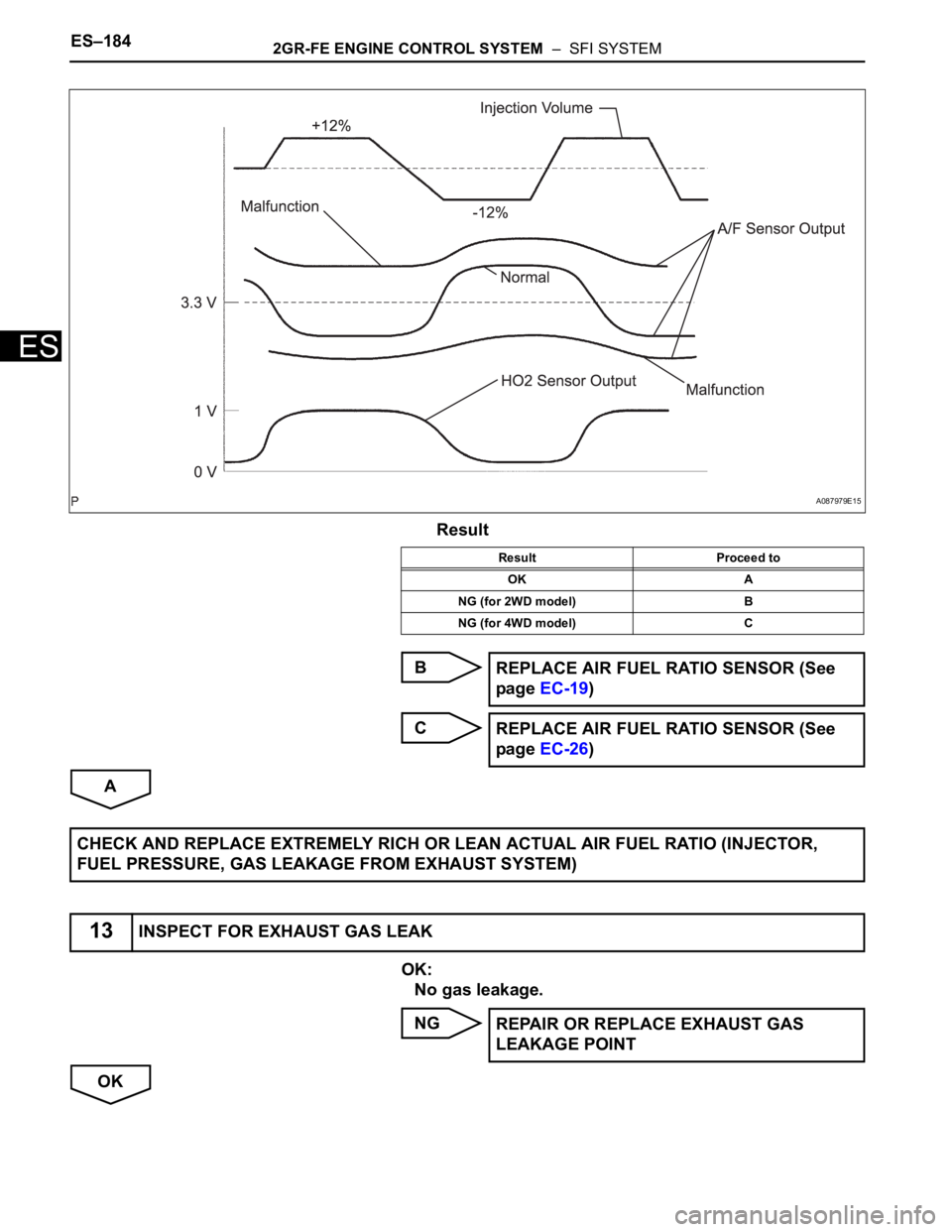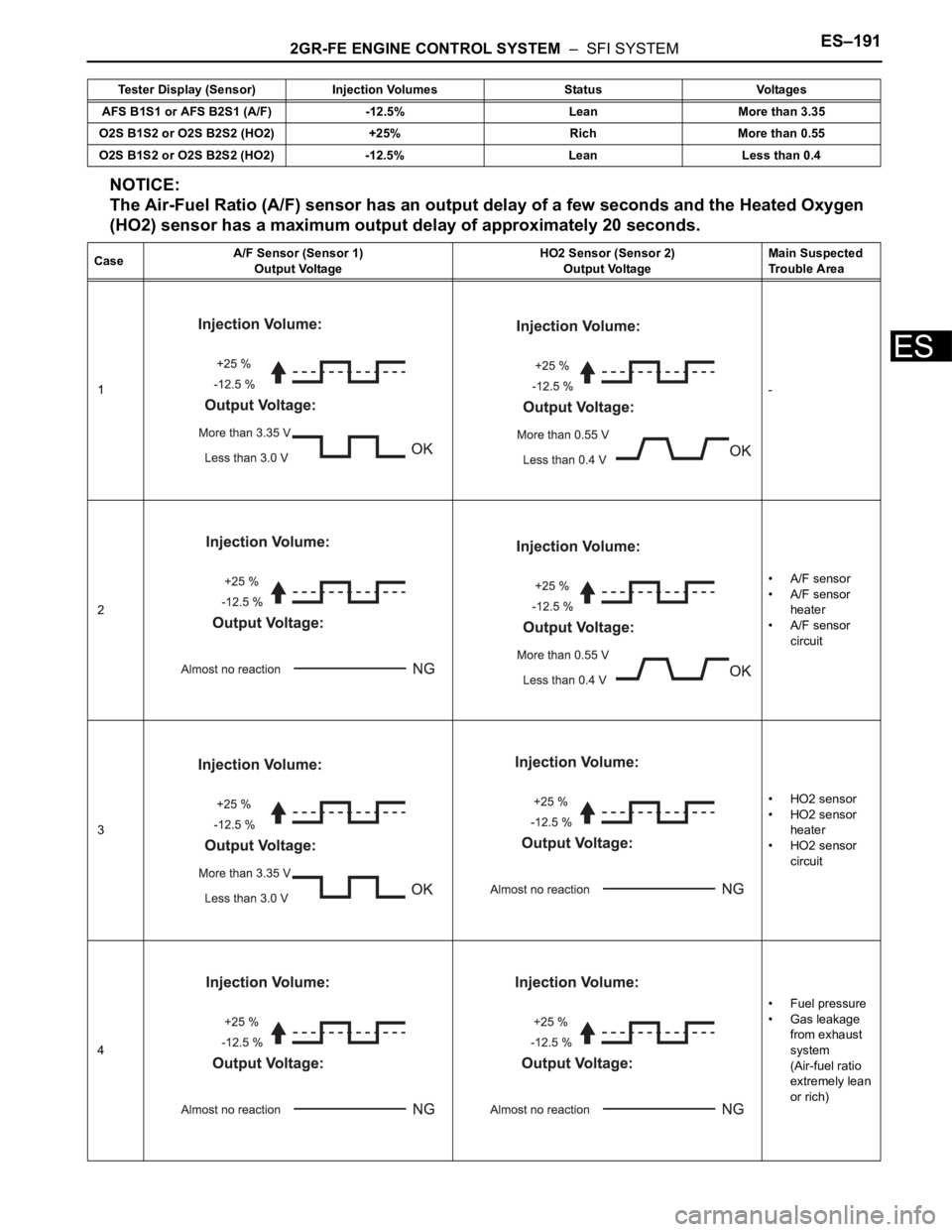2007 TOYOTA SIENNA fuel pressure
[x] Cancel search: fuel pressurePage 389 of 3000

2GR-FE ENGINE CONTROL SYSTEM – SFI SYSTEMES–83
ES
DESCRIPTION
The Variable Valve Timing (VVT) system includes the ECM, Oil Control Valve (OCV) and VVT controller.
The ECM sends a target duty-cycle control signal to the OCV. This control signal regulates the oil
pressure supplied to the VVT controller. Camshaft timing control is performed according to engine
operating conditions such as intake air volume, throttle valve position and engine coolant temperature.
The ECM controls the OCV, based on the signals transmitted by several sensors. The VVT controller
regulates the intake camshaft angle using oil pressure through the OCV. As a result, the relative positions
of the camshaft and crankshaft are optimized, the engine torque and fuel economy improves, and the
exhaust emissions decrease under overall driving conditions. The ECM detects the actual intake valve
timing using signals from the camshaft and crankshaft position sensors, and performs feedback control.
This is how the target intake valve timing is verified by the ECM.
DTC P0010Camshaft Position "A" Actuator Circuit (Bank
1)
DTC P0020Camshaft Position "A" Actuator Circuit (Bank
2)
DTC No. DTC Detection Condition Trouble Area
P0010Open or short in OCV for intake camshaft (bank 1)
circuit
(1 trip detection logic)• Open or short in OCV for intake camshaft (bank 1)
circuit
• OCV for intake camshaft (bank 1)
•ECM
P0020Open or short in OCV for intake camshaft (bank 2)
circuit
(1 trip detection logic)• Open or short in OCV for intake camshaft (bank 2)
circuit
• OCV for intake camshaft (bank 2)
•ECM
A103843E02
Page 401 of 3000

2GR-FE ENGINE CONTROL SYSTEM – SFI SYSTEMES–95
ES
DESCRIPTION
The Variable Valve Timing (VVT) system includes the ECM, OCV and VVT controller. The ECM sends a
target duty-cycle control signal to the OCV. This control signal regulates the oil pressure supplied to the
VVT controller. Camshaft timing control is performed according to engine operating conditions such as the
intake air volume, throttle valve position and engine coolant temperature. The ECM controls the OCV,
based on the signals transmitted by several sensors. The VVT controller regulates the exhaust camshaft
angle using oil pressure through the OCV. As a result, the relative positions of the camshaft and
crankshaft are optimized, the engine torque and fuel economy improve, and the exhaust emissions
decrease under overall driving conditions. The ECM detects the actual exhaust valve timing using signals
from the camshaft and crankshaft position sensors, and performs feedback control. This is how the target
intake valve timing is verified by the ECM.
DTC P0013Camshaft Position "B" Actuator Circuit / Open
(Bank 1)
DTC P0023Camshaft Position "B" Actuator Circuit / Open
(Bank 2)
DTC No. DTC Detection Condition Trouble Area
P0013Open or short in OCV for exhaust camshaft (bank 1)
circuit
(1 trip detection logic)• Open or short in OCV for exhaust camshaft (bank
1) circuit
• OCV for exhaust camshaft (bank 1)
•ECM
P0023Open or short in OCV for exhaust camshaft (bank 2)
circuit
(1 trip detection logic)• Open or short in OCV for exhaust camshaft (bank
2) circuit
• OCV for exhaust camshaft (bank 2)
•ECM
A103843E02
Page 484 of 3000

ES–1782GR-FE ENGINE CONTROL SYSTEM – SFI SYSTEM
ES
– Following the A/F CONTROL procedure enables technicians to check the graph of the voltage
outputs of both the A/F and HO2 sensors.
– To display the graph, select the following menu items on the tester: DIAGNOSIS / ENHANCED OBD
II / ACTIVE TEST / A/F CONTROL / USER DATA / AFS B1S1 and O2S B1S2 or AFS B2S1 and
O2S B2S2. Press the YES button and then the ENTER button. Then press the F4 button.
HINT:
• If other DTCs relating to different systems that have terminal E2 as the ground terminal are
output simultaneously, terminal E2 may have an open circuit.
• Read freeze frame data using the intelligent tester. The ECM records vehicle and driving
condition information as freeze frame data the moment a DTC is stored. When troubleshooting,
freeze frame data can be helpful in determining whether the vehicle was running or stopped,
whether the engine was warmed up or not, whether the air-fuel ratio was lean or rich, as well as
other data recorded at the time of a malfunction.
• If the OX1B wire from the ECM connector is short-circuited to the +B wire, DTC P0136 or P0156
will be set.
(a) Connect the intelligent tester to the DLC3.
2• A/F sensor
• A/F sensor
heater
• A/F sensor
circuit
3• HO2 sensor
• HO2 sensor
heater
• HO2 sensor
circuit
4•Fuel pressure
• Gas leakage
from exhaust
system
(Air-fuel ratio
extremely lean
or rich)
1READ DTC OUTPUT
CaseA/F Sensor (Sensor 1)
Output VoltageHO2 Sensor (Sensor 2)
Output VoltageMain Suspected
Trouble Area
Page 490 of 3000

ES–1842GR-FE ENGINE CONTROL SYSTEM – SFI SYSTEM
ES
Result
B
C
A
OK:
No gas leakage.
NG
OK
A087979E15
Result Proceed to
OK A
NG (for 2WD model) B
NG (for 4WD model) C
REPLACE AIR FUEL RATIO SENSOR (See
page EC-19)
REPLACE AIR FUEL RATIO SENSOR (See
page EC-26)
CHECK AND REPLACE EXTREMELY RICH OR LEAN ACTUAL AIR FUEL RATIO (INJECTOR,
FUEL PRESSURE, GAS LEAKAGE FROM EXHAUST SYSTEM)
13INSPECT FOR EXHAUST GAS LEAK
REPAIR OR REPLACE EXHAUST GAS
LEAKAGE POINT
Page 494 of 3000

ES–1882GR-FE ENGINE CONTROL SYSTEM – SFI SYSTEM
ES
DESCRIPTION
The fuel trim is related to the feedback compensation value, not to the basic injection time. The fuel trim
consists of both the short-term and long-term fuel trims.
The short-term fuel trim is fuel compensation that is used to constantly maintain the air-fuel ratio at
stoichiometric levels. The signal from the Air-Fuel Ratio (A/F) sensor indicates whether the air-fuel ratio is
rich or lean compared to the stoichiometric ratio. This triggers a reduction in the fuel injection volume if the
air-fuel ratio is rich and an increase in the fuel injection volume if it is lean.
Factors such as individual engine differences, wear over time and changes in operating environment
cause short-term fuel trim to vary from the central value. The long-term fuel trim, which controls overall
fuel compensation, compensates for long-term deviations in the fuel trim from the central value caused by
the short-term fuel trim compensation.
If both the short-term and long-term fuel trims are lean or rich beyond predetermined values, it is
interpreted as a malfunction, and the ECM illuminates the MIL and sets a DTC.
HINT:
• When DTC P0171 or P0174 is set, the actual air-fuel ratio is on the lean side. When DTC P0172 or
P0175 is set, the actual air-fuel ratio is on the rich side.
• If the vehicle runs out of fuel, the air-fuel ratio is lean and DTC P0171 or P0174 may be set. The MIL is
then illuminated.
DTC P0171 System Too Lean (Bank 1)
DTC P0172 System Too Rich (Bank 1)
DTC P0174 System Too Lean (Bank 2)
DTC P0175 System Too Rich (Bank 2)
DTC No. DTC Detection Condition Trouble Area
P0171
P0174With warm engine and stable air-fuel ratio feedback,
fuel trim considerably in error to lean side (2 trip
detection logic)• Intake system
• Injector blockage
• Mass Air Flow (MAF) meter
• Engine Coolant Temperature (ECT) sensor
• Fuel pressure
• Gas leakage from exhaust system
• Open or short in A/F sensor (bank 1, 2 sensor 1)
circuit
• A/F sensor (bank 1, 2 sensor 1)
• A/F sensor heater (bank 1, 2 sensor 1)
• A/F sensor heater relay
• A/F sensor heater and A/F sensor heater relay
circuits
• PCV valve and hose
• PCV hose connections
•ECM
P0172
P0175With warm engine and stable air-fuel ratio feedback,
fuel trim considerably in error to rich side (2 trip
detection logic)• Injector leakage or blockage
• MAF meter
• ECT sensor
• Ignition system
• Fuel pressure
• Gas leakage from exhaust system
• Open or short in A/F sensor (bank 1, 2 sensor 1)
circuit
• A/F sensor (bank 1, 2 sensor 1)
• A/F sensor heater (bank 1, 2 sensor 1)
• A/F sensor heater relay
• A/F sensor heater and A/F sensor heater relay
circuits
•ECM
Page 497 of 3000

2GR-FE ENGINE CONTROL SYSTEM – SFI SYSTEMES–191
ES
NOTICE:
The Air-Fuel Ratio (A/F) sensor has an output delay of a few seconds and the Heated Oxygen
(HO2) sensor has a maximum output delay of approximately 20 seconds.
AFS B1S1 or AFS B2S1 (A/F) -12.5% Lean More than 3.35
O2S B1S2 or O2S B2S2 (HO2) +25% Rich More than 0.55
O2S B1S2 or O2S B2S2 (HO2) -12.5% Lean Less than 0.4
CaseA/F Sensor (Sensor 1)
Output VoltageHO2 Sensor (Sensor 2)
Output VoltageMain Suspected
Trouble Area
1-
2•A/F sensor
•A/F sensor
heater
•A/F sensor
circuit
3•HO2 sensor
• HO2 sensor
heater
• HO2 sensor
circuit
4• Fuel pressure
• Gas leakage
from exhaust
system
(Air-fuel ratio
extremely lean
or rich) Tester Display (Sensor) Injection Volumes Status Voltages
Page 499 of 3000

2GR-FE ENGINE CONTROL SYSTEM – SFI SYSTEMES–193
ES
OK
(a) Connect the intelligent tester to the DLC3.
(b) Start the engine and turn the tester on.
(c) Warm up the engine at an engine speed of 2500 rpm for
approximately 90 seconds.
(d) Select the following menu items on the tester:
DIAGNOSIS / ENHANCED OBD II / ACTIVE TEST / A/F
CONTROL.
(e) Perform the A/F CONTROL operation with the engine in
an idling condition (press the RIGHT or LEFT button to
change the fuel injection volume).
(f) Monitor the voltage outputs of the A/F and HO2 sensors
(AFS B1S1 and O2S B1S2 or AFS B2S1 and O2S
B2S2) displayed on the tester.
HINT:
• The A/F CONTROL operation lowers the fuel injection
volume by 12.5% or increases the injection volume by
25%.
• Each sensor reacts in accordance with increases and
decreases in the fuel injection volume.
Standard voltage
Result
4PERFORM ACTIVE TEST BY INTELLIGENT TESTER (A/F CONTROL)
Tester Display (Sensor) Injection Volumes Status Voltages
AFS B1S1 or AFS B2S1 (A/F) +25% Rich Less than 3.0
AFS B1S1 or AFS B2S1 (A/F) -12.5% Lean More than 3.35
O2S B1S2 or O2S B2S2 (HO2) +25% Rich More than 0.55
O2S B1S2 or O2S B2S2 (HO2) -12.5% Lean Less than 0.4
Status AFS
B1S1 or AFS
B2S1Status O2S
B1S2 or O2S
B2S2A/F Condition and A/F
Sensor ConditionMisfires Suspected Trouble Areas Proceed to
Lean/Rich Lean/Rich Normal - - C
Lean Lean Actual air-fuel ratio lean May occur• PCV valve and hose
• PCV hose connections
• Injector blockage
• Gas leakage from
exhaust system
• Air induction system
• Fuel pressure
• Mass Air Flow (MAF)
meter
• Engine Coolant
Temperature (ECT)
sensorA
Rich Rich Actual air-fuel ratio rich -• Injector leakage or
blockage
• Gas leakage from
exhaust system
• Ignition system
• Fuel pressure
• MAF meter
• ECT sensorA
Lean Lean/Rich A/F sensor malfunction - A/F sensor B
Rich Lean/Rich A/F sensor malfunction - A/F sensor B
Page 501 of 3000

2GR-FE ENGINE CONTROL SYSTEM – SFI SYSTEMES–195
ES
Between 7.4 g/s and 18.9 g/s (shift position: N, A/
C: OFF).
NG
OK
(a) Check the fuel pressure (See page FU-7).
NG
OK
OK:
No gas leakage.
NG
OK
(a) Check for sparks and ignition (See page ES-217).
HINT:
If the spark plugs or ignition system malfunctions, engine
misfire may occur. The misfire count can be read using
the intelligent tester. Select the following menu items:
DIAGNOSIS / ENHANCED OBD II / DATA LIST /
PRIMARY / CYL #1 (to CYL #6).
NG
OK
(a) Inspect the fuel injector assembly (See page FU-16).
HINT:
If the injectors malfunction, engine misfire may occur.
The misfire count can be read using the intelligent tester.
Select the following menu items: DIAGNOSIS /
ENHANCED OBD II / DATA LIST / PRIMARY / CYL #1
(to CYL #6).
NG
OKREPLACE MASS AIR FLOW METER (See
page ES-504)
7CHECK FUEL PRESSURE
REPAIR OR REPLACE FUEL SYSTEM
8INSPECT FOR EXHAUST GAS LEAK
REPAIR OR REPLACE EXHAUST SYSTEM
9CHECK FOR SPARKS AND IGNITION
REPAIR OR REPLACE IGNITION SYSTEM
10INSPECT FUEL INJECTOR ASSEMBLY (INJECTION AND VOLUME)
REPLACE FUEL INJECTOR ASSEMBLY (See
page FU-13)